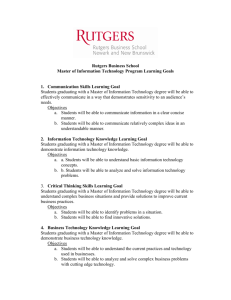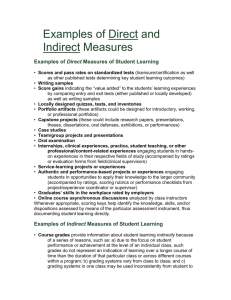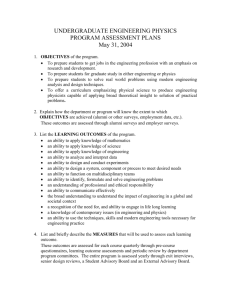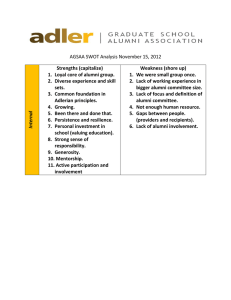Boise State University Department of Construction Management 2012-2013 Quality Assessment Report and
advertisement
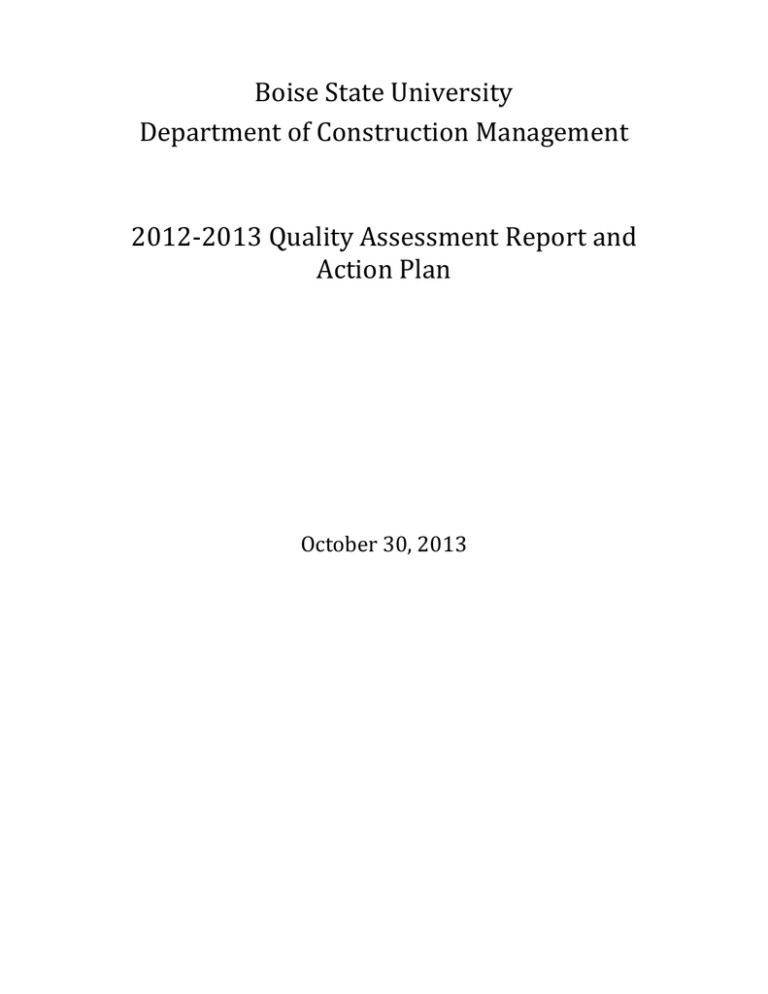
Boise State University Department of Construction Management 2012-2013 Quality Assessment Report and Action Plan October 30, 2013 Executive Summary In the spring of 2013 the Construction Management Program underwent a six-year accreditation visit by a team from ACCE. As a result, and going along with our data collection plan information was obtained from two primary sources in order to assess the achievement of our stated Program Outcomes and Objectives. This report presents and provides an analysis of data from: American Institute of Constructors Level I Exam (November 2012 and April 2013) Graduating Senior Exit Surveys In addition, the report provides information on assessment measures scheduled for 2013-2014. Data gathered in 2012-2013 indicate that graduates continue to perform at a higher level than national averages in similar programs in content areas related to our stated Program Outcomes. Graduating senior exit surveys have been redesigned to directly request feedback that can be tied to specific Program Outcomes. This new set of questions will be used beginning in the fall of 2013. i Mission To provide comprehensive educational opportunities, applied research, and service-oriented outreach for the development of future professional constructors who, through innovation, character and ability are prepared to meet the construction needs of society and provide leadership to the construction industry. Vision To be recognized and respected for providing consistent, creative, high quality, student centric education, applied research, and community focused outreach, with a clear emphasis on ethics, sustainability and leadership. Program Outcomes Program Outcomes are defined as the knowledge and skills we expect our students to possess at the time of graduation. Upon successful completion of the Construction Management course of study, graduates can be expected to demonstrate: 1. An ability to apply knowledge of mathematics, engineering, business, and economics to solve construction problems. 2. An ability to read and interpret construction plans, specifications and documents to accurately estimate direct and indirect construction project costs. 3. An ability to apply knowledge of construction materials, methods and equipment to safely and effectively plan and sequence construction activities and processes within realistic constraints such as economic, environmental, social, political, ethical, health and safety, and sustainability. 4. An ability to apply knowledge of procurement practices, regulatory requirements, and construction contract law applicable to construction project management and administration. 5. An ability to function as part of a diverse team, using the techniques, skills, and current technology necessary for professional construction industry practice, to ethically manage a construction project within established constraints of budget, schedule, quality, safety, and regulatory compliance. 6. An understanding of professional and ethical responsibility. 7. An ability to communicate effectively. 8. The broad education necessary to recognize economic, environmental and societal impacts of construction projects. Program Objectives Program Objectives are defined as the abilities we expect our alumni to exhibit three to five years after graduation. Students who are granted the Bachelor of Science in Construction Management will demonstrate knowledge and understanding in the following areas: 1. General Education - Graphic, oral and written communications, and the understanding of human factors. 2. Math and Science – Principles of mathematics, statistics and physics in order to appropriately anticipate the behavior of the materials, equipment, and methods used in construction. 3. Business and Management – The demands of working in a global environment including: 1 knowledge of sustainability, accounting, finance, business regulations, contract law, labor law, and marketing practices. The fundamentals of contemporary management and business practices appropriate to the construction profession. 4. Construction Science – The contribution of other professional disciplines to the construction process. The ability to lead, coordinate, communicate and interact with professionals in various disciplines to solve project challenges. 5. Construction – The total project process including: concept, design, procurement, construction, and delivery of the functioning project. The constructor’s professional responsibility as a leader and member of a multi-disciplinary team, working in diverse environments, assessing risks, and showing definitive progress, all while maintaining priorities in safety, sustainability, purpose, business, and societal issues. 6. Life-Long Learning – An appreciation of the need for, and the value of, leadership, collaboration, productivity, and professionalism in sustaining or developing one’s own career growth. Program Quality Assessment The Construction Management department has an established process of assessment and improvement, as depicted in the figure below. Each course offered by the department has established a series of Course Outcomes that are measurable learning outcomes specific to each course. Course Outcomes must support the Program Outcomes and Objectives. In turn, the Program Outcomes and Objectives must support the Mission and Vision of the program. Mission & Vision Goals: Program Outcomes & Objectives Students Review by Faculty Review by Faculty Curriculum Review & Comment by Constituent Groups: Students Alumni Industry Advisory Committee Review & Comment by Constituent Groups Assessment Plan: Are the Course Outcomes Achieved? Graduates Assessment Plan: Are the Program Objectives Achieved? Review & Comment by Constituent Groups Assessment Plan: Are the Program Outcomes & Objectives Appropriate? 2 Performance of our current students and graduates is measured in a number of ways, including: results of the comprehensive American Institute of Constructors (AIC) Exam; review of student work; graduating senior exit survey; alumni and industry surveys; and input from the program’s industry advisory board. This assessment information is compared to our desired performance, which is articulated in the Program Outcomes and Objectives. Any gap or discrepancy between our actual and desired performance indicates that a modification is needed, either within the curriculum, or to the Program Outcomes or Objectives. This process is driven by program faculty both directly (through day-to-day involvement with course design, delivery, assessment, and evaluation), and indirectly (through the influence of service and research). Assessment of Program Outcomes The table below lists our planned assessment methods for each Program Outcome listed previously (page 1). PROGRAM OUTCOMES ASSESSMENT PLAN Assessment Measure: American Institute of Constructors Level 1 (Associate Constructor) Exam This comprehensive exam, which covers all aspects of construction project management, is taken by all graduating seniors. Review of Student Work This is a review of student performance on tests and assignments relative to the stated learning objectives for every CMGT course. This is an ongoing assessment. Outcomes Addressed: (list by number) 1, 2, 3, 4, 5, 7 All 3 How is the information used? Timeline Scores are an assessment of student learning in the test subject areas in comparison to national averages. Scores equal to or higher than national averages indicate the learning goals are being achieved. Scores below the national averages or indicating a weakness lead to a faculty review of the curriculum to identify classes where course content can be revised to address the weakness. Faculty review student performance on selected assignments, projects or exams to measure whether the program outcomes are being achieved and at what level. Faculty address weaknesses by revising content or course objectives as appropriate. Twice per year (November and April) The 8 Program Outcomes are reviewed on a 3-year cycle PROGRAM OUTCOMES ASSESSMENT PLAN (continued) Assessment Measure: Graduating Senior Exit Survey These questionnaires are designed to evaluate the level at which graduating seniors believe they have achieved the CM Program Outcomes. Industry/Employer Surveys These questionnaires are designed to evaluate the relevance and achievement of CM Program Outcomes with respect to current industry requirements. Goals Addressed: (list by number) All All How is the information used? Timeline Faculty review questionnaires completed by graduating students to identify areas in the curriculum which the students feel are not being addressed to their satisfaction. Faculty address weaknesses by revising course objectives or content as appropriate. Faculty review questionnaires completed by Industry and Employers to identify areas in the curriculum which members of industry feel are not being adequately taught based on graduate knowledge and job performance. If the Respondent does not employ Boise State CM grads, they may provide feedback about the relevance of the Program Outcomes. Faculty address weaknesses by revising program outcomes, or course objectives or content as appropriate. At the end of every semester Every three years. Assessment of Program Objectives The table below lists our planned assessment methods for each Program Objectives listed previously (page 1). PROGRAM OBJECTIVES ASSESSMENT PLAN Assessment Measure: Alumni Surveys These questionnaires are designed to evaluate the achievement of CM Program Objectives (at 3 to 5 years postgraduation). Objectives Addressed: (list by number) All 4 How is the information used? Faculty review questionnaires completed by alumni to identify areas in which the graduates, upon exposure to industry requirements, feel did not adequately prepare them for employment. Faculty address weaknesses by revising course objectives or content as appropriate. Timeline Every three years Summary of the most recent assessment cycle Consistent with the Assessment Plan, the following sections provide a summary presentation and analysis of data collected during the most recent assessment cycle. American Institute of Constructors Level I Exam The bar charts below show the results of the November 2012 and April 2013 AIC Level I Exams. The values shown in the first chart are based on a comparison of the average score obtained by Boise State students compared to the scores that AIC considers to be the minimum acceptable using the following relationship: BSU Average Minimum Score 1 Using this relationship all 10 sections of AIC Level I Exam are normalized to zero. Scores greater than zero mean our students are performing above the minimum acceptable value, and scores below zero means our students are performing below the minimum acceptable value. Ave 1 MinBSUScore 1. Communication Skills 2. Engineering Concepts 3. Management Concepts 4. Materials, Methods & Project Modeling 5. Bidding & Estimating 6. Budgeting Cost Controls 7. Planning Schedule & Control 8. Construction Safety 9. Construction Geomatics 10. Project Administration Although Boise State Construction Management students consistently perform above the minimum scores in most areas covered, scores in the content areas of Communication Skills, Engineering Concepts and Bidding and Estimating fall below the AIC minimum acceptable score on at least one test for the year under review. Ave BSU Nat. Ave 1 1. Communication Skills 2. Engineering Concepts 3. Management Concepts 4. Materials, Methods & Project Modeling 5. Bidding & Estimating 6. Budgeting Cost Controls 7. Planning Schedule & Control 8. Construction Safety 9. Construction Geomatics 10. Project Administration When comparing the work of Boise State students to the National Average it is seen that even in the areas of concern listed above Boise State students outperform the National Average across the board. 5 Follow-up Action The areas of Communication Skills, Engineering Concepts and Bidding and Estimating have been discussed by the faculty. It was noted that when observing a longer trend than just a single year Bidding and Estimating is not normally a problem area for our students. It was also noted that for the two tests addressed here the national average in Bidding and Estimating was extremely low, with Boise State students scoring well above the National Average. As a result it is assumed that these two tests were an aberration, but future results in this area will be closely monitored. The area of Engineering Concepts is also one where when a longer period is observed the test from November of 2012 is seen as abnormal. The department has decided to adjust how some of this material is delivered in various courses to address this issue. The area of Communications Skills has previously been addressed by the creation of a new course in Construction Communications, implemented in Fall 2012. The results of this effort are yet to be seen in the AIC exam. Review of Student Work Over the years between ACCE visits student work is reviewed by Program Outcome where select courses are identified by their association with Program Outcomes to be reviewed. The year leading up to an ACCE visit, which occurred in the spring of 2013, course binders were collected and reviewed for all courses and all outcomes in the curriculum. Follow-up Action The result of the ACCE visit were presented to the department. No changes were made to the curriculum based on the findings of the visit. A 3-year cycle for review of Program Outcomes was established to address this data for future annual reports (see Attachment 1). 2013-2014 School year – Outcomes 1, 4 &5 2014-2015 School year – Outcomes 2 & 3 2015-2016 School year – Outcomes 6, 7 & 8 2016-2017 School year – Outcomes 1, 4 &5 2017-2018 School year – Outcomes 2 & 3 2018-2019 prepare 6-year report, review all courses 6 Graduating Senior Exit Surveys A questionnaire is given at the end of every semester by the Department to graduating seniors to assess student perception of their achievement of the program learning outcomes. Eighteen surveys were completed for Fall 2012 and four surveys were completed in the Spring of 2013. Note that the program learning outcomes included on the student surveys were those listed prior to the 2012 revision. Results are shown in the figures below. These results show that in both semesters the students felt that they had significantly improved the knowledge and understanding of all aspect of Construction Management. In the Fall the area in which students felt they had learned the most between entering and exiting the program was in having the knowledge and ability to schedule projects using modern tools (Program Outcome #7). In the Spring the area in which the students felt that they had achieved the most learning was in understanding the various aspects of project management and administration (Program Outcome #10). Graduating Student Exit Surveys Fall 2012 (n = 18) 5.00 4.00 3.00 2.00 1.00 1 2 3 4 5 6 7 8 9 10 11 12 13 At Graduation 4.22 4.33 4.11 4.39 4.22 3.89 4.06 4.11 4.06 4.39 4.28 4.50 3.78 When I Started 2.50 1.94 1.61 2.67 2.00 1.72 1.11 1.78 1.28 1.83 1.67 2.61 1.56 Spring 2013 (n = 4) 5.00 4.00 3.00 2.00 1.00 1 2 3 4 5 6 7 8 9 At Graduation 10 11 12 13 4.50 4.75 4.75 5.00 4.63 4.63 4.67 4.00 4.50 4.75 4.75 4.50 4.38 When I Started 2.75 2.50 2.00 3.67 2.50 1.75 2.33 1.75 2.00 1.75 2.50 2.25 1.50 Responses given on a scale of 1 to 5, from least to greatest achievement. 7 Items 1 through 13 refer to Previous Program Learning Outcomes Used in the 2012 – 2013 Graduating Senior Exit Surveys 1. Demonstrate a proficiency in all forms of communication. 2. Be able to read and interpret contract plans, specifications and documents. 3. Be able to accurately estimate construction projects with the use of modern tools. 4. Be knowledgeable of the necessity for professional integrity and ethical responsibility. 5. Be knowledgeable of materials, and be able to employ appropriate methods for their use and application. 6. Use their knowledge of productivity, utilization and efficiency to determine the selection of appropriate equipment for various types of projects. 7. Have the knowledge and ability to schedule projects using modern tools. 8. Understand and apply the basic principles of business and economics. 9. Be knowledgeable of the major issues concerning contract law. 10. Demonstrate an understanding of the various aspects of project management and administration. 11. Be knowledgeable of safety regulations and safe project management and control. 12. Perform well in a multi-disciplinary team environment. 13. Demonstrate knowledge of engineering principles for construction applications. Follow-up Action Based on the results of the Senior Exit Survey from the Fall of 2012 it is clearly seen that the students feel that they have learned a great deal in their education. In addition to the 13 questions listed above the student were also asked to provide feedback on what they liked about the program, what they did not like and what they thought could be improved. These results were discussed with the faculty leading to minor adjustments in what material is delivered as well as an affirmation to continue to work to keep the program up to date and to offer students as many opportunities as possible. The Department has revised the questions on the Senior Exit Survey to align with the program Outcomes (see Attachment 2). The new survey will also be administered electronically to allow for more anonymity and more detailed responses. Students will also continue to have the option to meet with the Department Chair if they choose to do so. The Department will continue to conduct the graduating senior exit surveys each semester in order to identify trends that persist over the long term. Alumni Surveys In June 2011, alumni who had graduated from the program between Fall 2005 and Spring 2008 (graduating roughly three to five years prior to the survey) were contacted by email and provided with a link to an online survey. Follow-up Action Faculty will continue to review these comments in conjunction with the related comments from the Industry / Employer survey. The next Alumni Survey is to be deployed in the summer of 2014. 8 Industry / Employers Questionnaires The Industry/Employer questionnaire which is administered every 3 years was deployed in Fall 2012. Fall 2012 Industry / Employer Survey Results Scores are based on a scale from 1 to 5, with 1 = Strongly Disagree and 5 = Strongly Agree Program Outcome Score 1 An ability to apply knowledge of mathematics, engineering, business, and economics to solve construction problems. n = 18 2 An ability to read and interpret construction plans, specifications and documents to accurately estimate direct and indirect construction project costs. n = 17 3 An ability to apply knowledge of construction materials, methods and equipment to safely and effectively plan and sequence construction activities and processes within realistic constraints such as economic, environmental, social, political, ethical, health and safety, and sustainability. An ability to apply knowledge of procurement practices, regulatory requirements, and construction contract law applicable to construction project management and administration. An ability to function as part of a diverse team, using the techniques, skills, and current technology necessary for professional construction industry practice, to ethically manage a construction project within established constraints of budget, schedule, quality, safety, and regulatory compliance. 4 5 6 An understanding of professional and ethical responsibility. 7 An ability to communicate effectively. 8 The broad education necessary to recognize economic, environmental and societal impacts of construction projects. 3.94 3.88 3.82 n = 17 3.56 n = 18 4.11 n = 18 3.94 n = 18 3.78 n = 18 3.72 n = 18 The results of the survey indicate that our employers and industry associates generally agree that graduates have achieved the established learning outcomes, particularly for outcome number five. When asked how they would rate the education of Boise State Construction Management graduates on a scale of 1 to 100, the average score was 82.5%. On a letter grade scale, this would be right on the dividing line between a ‘B’ and a ‘B-‘. These results were very similar to the results from the 2005 Industry / Employer survey. In the individual comments, respondents stressed the importance of internships, which would seem to indicate that employers are rating their hires on experience as well as academic education. The results are provided in Attachment 3. Follow-up Action The next Industry / Employer survey is scheduled to take place in 2015. Until then, we will continue to solicit industry feedback from our Advisory Council membership. 9 Advisory Council Feedback In Fall 2011, Construction Management Advisory Council members were tasked with reviewing the course objectives for each CMGT course and providing feedback on importance and relevancy. This is intended to be an ongoing activity, although the cycle frequency has not yet been determined. Follow-up Action Feedback received for several courses was useful in observing gaps between industry practice in specific sectors, and the broad-based educational goals of our curriculum. The process served as a valuable communication mechanism between industry and faculty. Additional Assessment Measures Construction Competition Results. Boise State Construction Management student teams participating in the annual Associated Schools of Construction (ASC) Region VI competition were competitive with student teams from other construction management programs in our region. The Determining Project Risk team placed 3rd. Success in the student competition requires outstanding performance in teamwork, time management, and oral presentations in front of a live industry judging panel, as well as comprehensive knowledge and understanding of construction materials and methods, drawings, contract documents, cost estimating, scheduling, and project management and administration. 10 Attachment 1 Review of Student Work Template 11 Attachment 2 Senior Exit Survey (Revised Fall 2013) 12 Attachment 3 Industry / Employer Survey - Fall 2012 13
